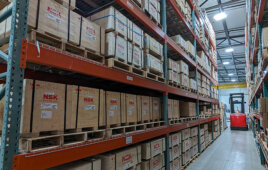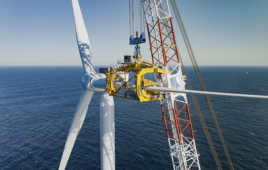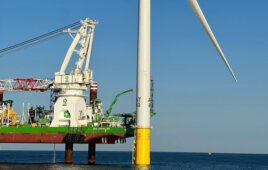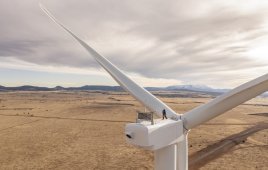By Andras Kaldos, Product Engineering Group Manager, Key Industries, James Walker
 In recent years wind turbines have made significant increases in size as operators and OEMs seek to optimize the costs of power generation by building fewer larger and more efficient turbines. Whilst these will produce substantially more energy than they take to manufacture, install and maintain, larger units do present significant challenges.
In recent years wind turbines have made significant increases in size as operators and OEMs seek to optimize the costs of power generation by building fewer larger and more efficient turbines. Whilst these will produce substantially more energy than they take to manufacture, install and maintain, larger units do present significant challenges.
In mechanical terms, an increase in size means an increase in the loads generated throughout the equipment, in turn leading to more stress being imposed on virtually every component in the system, but particularly on rotating and transmission components.
Seal performance
Elastomeric rotary lip-seals of the type used to seal bearings and rotating shafts follow a long-established seal design that has changed little over the years and is now being required to achieve new levels of performance at a reduced cost. With loads on the main shaft of a large wind turbine being high enough to cause flexing and distortion of bearings, it falls to the seal to cope with any eccentricity of movement while still performing its intended duties of preventing the escape of lubricant and the ingress of contamination.
Lip-seals were also originally designed to work with oil as a lubricant, their sealing principle relying on the sealing lip running on a thin film of oil on the surface of the shaft. In modern wind turbines however, the vast majority of bearings now use high-performance greases for lubrication, bringing a whole new dynamic to the operation of the bearing seal.
With turbines now expected to achieve a working life of 20+ years and the industry driving to achieve higher load capacities, there is a demand for components to offer efficiency benefits in addition to long life.
In line with the aim of improving load factors and reducing overall generating costs, all elements of a turbine are being brought under close cost scrutiny, forcing the whole supply chain to seek ways of taking cost down while also delivering the improvements in performance demanded by increasingly harsh operating environments and the increase in turbine size.
Faced with these growing challenges, James Walker decided to take a closer look at every element of the large-diameter lip-seals required for the wind industry and see what could be done to meet current and future needs. Nothing was off-limits.
Marginal gains can provide significant benefits
As part of this investigation and in collaboration with customers in the wind industry, detailed finite element analysis (FEA) modeling and in-house dynamic testing was undertaken and led to James Walker redesigning its existing seal-lip, Walkersele. By breaking the Walkersele down into its “constituent parts” and making small but significant improvements in each of these areas, James Walker has taken an already successful and proven product and pushed it to deliver new levels of reliability and performance to meet customer demands.
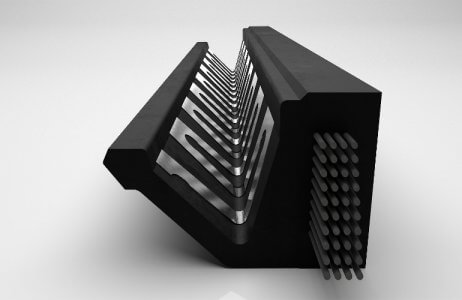
Walkersele X-Gen
Identifying that a “finger” spring would provide the necessary assistance required to accommodate eccentricity/deflection and maintain a constant/linear lip-load at all points on the shaft, modeling techniques also allowed engineers to refine the spring design, optimizing it for the material and diameter of the seal.
Once the sealing element was optimized, the focus moved to the backing material and the result of a comprehensive program of experimentation and testing is a new innovative rubber/glass fiber composite material in which the glass strands are aligned circumferentially, providing enhanced dimensional stability yet retaining full flexibility that makes a large diameter seal of this construction easier to fit into its housing.
The new product, called Walkersele X-Gen, meets the challenges thrown by the increasing size of turbine designs — maintaining effective sealing against deflected shafts or housings and increased offset, plus enhanced retention of sealing forces over the full circumference of the sealing face.
Supporting operations and maintenance demands
Throughout this project James Walker has been working in partnership with a number of OEMs seeking to test factors such as seal rotation in the housing, lip load, leakage performance and life expectancy.

Walkersele X-Gen
Product development and validation testing has all been carried out in-house at the James Walker centre of excellence for elastomeric materials in the UK. Further real-life simulation testing was then carried out by OEMs using commercially produced seals on full-size housing/shaft/bearing setups.
Due to the sizes of seal required for the next generation of turbines, the joining capability of the new glass-elastomer material was also fully tested through a comprehensive regime of twist and flex motions. The conclusion drawn from these results was that the new material provides a strong homogenous bond across the area of the join, equal to or better than that observed with any alternative backing constructions.
The developed solution has demonstrated excellent capabilities in terms of maintaining shaft contact and preventing leakage or the ingress of contaminants, even when faced with eccentric running or extreme shaft deflection.
As technology progresses and demands for turbines change and increase, it is important to be able to rely on the sealing technology to reduce risk and unnecessary, unplanned maintenance. The reinvention of this particular seal aims to do that, optimizing efficiency through prolonged seal life and ultimately giving operators peace of mind.
 Andras Kaldos is Product Engineering Group Manager for Key Industries at James Walker. Andras is based at the James Walker Centre of Excellence for elastomeric materials in Cockermouth, UK, and was part of the time involved in the research, development, design and testing of Walkersele X-Gen.
Andras Kaldos is Product Engineering Group Manager for Key Industries at James Walker. Andras is based at the James Walker Centre of Excellence for elastomeric materials in Cockermouth, UK, and was part of the time involved in the research, development, design and testing of Walkersele X-Gen.
Filed Under: Components, Featured, Seals & slip rings

